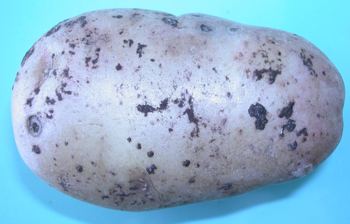Diseases
Thanatephorus cucumeris (Frank) Donk. (anamorpha Rhizoctonia solani Kuehn.) - Stem Canker and Black Scurf on potatoes
Systematic position.
Class Basidiomycetes, family Ceratobasidiacea, species T. cucumeris Donk.; anamorpha R. solani (Mitosporic fungi).Biological group.
Hemibiotrophic pathogen.Biology and morphology.
Infects tubers, stems, stolons, and roots of adult potato plants. The fungus forms dark brown to black encrustations (sclerotia) on the surface of affected tubers; the sclerotia vary in size and look somewhat like bits of black soil. Dark brown lesions known as stem canker develop on sprouts and roots. A whitish-gray covering over the base of the potato stem caused by teleomorph is visible later in the growing season under favorable weather conditions. R. solani survives in soil on decomposing plant residues and (as sclerotia) on infected tubers. At high humidity and low temperature the mycelium arising from germinated sclerotia can attack young sprouts, causing canker blotches. Mycelium is dark brown; sclerotia are brownish-black, having irregular form. Sexual stage of the fungus is observed in the middle of summer on radical part of stems.Distribution.
Stem Canker and Black Scurf are widely distributed in potato growing regions, being more significant in North-West, Central Volga-Vyatka, Ural regions of Russian Federation, West and East Siberia, Far East, Baltic countries, Belarus, woodlands of Ukraine, north and central regions of Kazakhstan.Ecology.
Caused agent develops under high air humidity and temperature 9 to 27oC (optimum from 15 to 21oC). Cold weather since the period of potato planting till sprouting and strong soil overwetting strengthen disease harmfulness.Economic significance.
Disease harms at all forms of the diseases appearances, affecting young sprouts during storage of tubers and vegetation period, attacking stems below or above the soil surface, and covering tubers with sclerotia. The highest harmfulness is observed, if a number of cancers develops on young sprouts at the beginning of tuber germination; therefore the first sprouts often die before reaching the soil surface, or their emergence is delayed, and there is a reduction in the number of stems produced, and as a result, the yield losses are observed. During the storage period the molds can develop on infected tubers. Protection measures include crop rotation, application of optimal doses of organic and chemical fertilizers, optimal time and depth for tubers planting, suitable and well-timed care and harvest, use of healthy seed potatoes, use of fungicides for treating seed potatoes.Related references.
Bertel.ts A.O., Bubentsov S.T. 1958. Black scurf of potato in Central Kazakhstan and protection measures // Trudy NII zashity rastenii. - Uralsk - V.4. - P.52-59 (in Russian).Bordukova M. 1970. Black scurf of potato and whitish-gray mildew on stem // Kartofel. i ovoshchi. - N4. - P.42-44 (in Russian).
Bubentsov S.T., Sechkina T.Yu. 1976. Black scurf of potato and protection measures // Puti uvelicheniya proizvodstva kartofelya v Uzbekistane. - Tashkent. - P.120-122. (in Russian).
Chumakov A.E, Zakharova T.I. 1990. Harmfulness of diseases of agricultural crops. . Moscow: Agropromizdat. . 127 pp. (in Russian).
Gross O.K. 1985. Black scurf of potato // Zashchita rastenii. - N2. - P.56 (in Russian).
Ivanyuk V.G., Aleksandrov O.T. 2000. Singularity of appearance of potato black scurf in Byelorussia // Mikologiya i fitoptologiya. - V.34(5). - P.51-59 (in Russian).
Hawksworth D.L., Kirk P.M., Sutton B.C., Pegler D.N. 1995. Dictionary of the fungi. - CAB International, - 616 p.
Kostitsin V.V., Tsvetkova N.A. 1997. Black scurf of cereals and potato // Zashchita rastenii i karantin. - N10. - P.32 (in Russian).
Leichenkova S.V. 1985. Morphological-cultural characteristics and pathogenicity of Rhizoctonia solani Kuehn. from different ecological-geographic regions // Selektsia i semenovodstvo kartofelya. - Moskow . -P.86-92 (in Russian).
Lisutina N.I. 1967. Black scurf in Kursk region // Nauchnye trudy (Agronomiya). - Kursk. - V.4. - P.193-115 (in Russian).
Peresypkin V.F.1989. Agricultural phytopathology. . Moscow: Agropromizdat. . 480 pp. (in Russian).
Popkova K. V., Shneider A.S., Volovik A.S., Shmuglya V.A. 1980. Diseases of potato. - Moscow: Kolos. - 304 pp. (in Russian).
Sechkina T.Y. 1978. Black scurf of potato and protection measures // Voprosy rasvitiya selskogo hozyastva v zone Kokchetavskogo melkosopochnika (Sbornik nauchnykh statei). . Alma-Ata: Kainar. - P.124-125 (in Russian).
Volovik A.S., Litun B.P., Fedorova M.I. 1974. Harmfulness of most spread diseases of potato in RF and economic effectiveness of protection measures // Tekhnologiya proizvodstva kartofelya (Nauchnye trudy). - Moskow. - V.XIX. - P.177-183 (in Russian).
Volovik A.S., Litun B.P. 1975. Harmfulness of potato diseases // Zashchita rastenii. - N7. - P.4-6 (in Russian).
Zaikin B.A. 2003. Struggle against potato diseases requires a complex approach // Kartofel' i ovoshchi. - N3. - P.25-27 (in Russian).
Zolotareva E.V., Mamakova T.F. 1984. Black scurf on potatoes in Khabarovsk Terrotory // Zashchita rastenii ot vreditelei, boleznei i sornyakov na Dal'nem Vostoke. - Novosibirsk -P.4-13 (in Russian).


